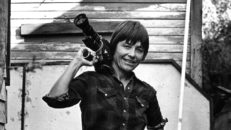
In Caroline Berler’s excellent investigation into lesbian cinema, which is a must see for any queer cinephile, she attempts to give us a female version of The Celluloid Closet. It is a valiant attempt as there are not nearly as man queer women’s movies and they have always been overlooked by those produced by gay men. Although lesbian movies enjoy far more exposure and success than they did before, you are left feeling this is still too little as well as being too late.
Berler starts back when lesbian movies always had a tragic ending reinforcing the myth that they could never be happy in real life. And as much as we adored Beryl Reed’s Golden Globe nominated performance in The Killing of Sister George in 1968, the American & British Censors made sure that the release of the movie even with its traumatic finish was severely restricted.
“Sister George,’ also typical of any lesbian movies as that time, was written and directed by straight men.
The 1970’s saw the emergence of experimental films made by a new wave of lesbian filmmakers but it really took until the 1990’s for them to finally break through and getting their work shown in LGBTQ Film Festivals that started popping up around the globe.
A lot of that early work rarely reached audiences and looking at the clips that Berler includes are probably being seeing by many of us for the very first time. She does go on to credit Rose Troche, and her film Go Fish (1994) for her landmark film that tried so hard to cheer up audiences during the AIDS pandemic. And then covers the a small steady flow of movies that slowly started to achieve better distribution that enabled them to reach both lesbian and mainstream audiences
There is currently a major very public debate about the lack of women in the film industry in general which people finally seem to be taking notice of. What Berler reminds us of very clearly is that it is even tougher for queer women.
Of all the talking heads that assembled in front of the camera, the most impressive was queer journalist B Ruby Rich who once established the term New Queer Cinema. She enthusiastically shares her passion and in-depth knowledge and confirms that once lesbian movies started getting the exposure they deserved, there were (and are) very appreciative and sizable audiences.
Filmmakers like Desiree Akhavan (Appropriate Behaviour, The Miseducation of Cameron Post) are now getting the credit that the late Barbara Hammer never did, but at least she is recognised in this documentary for the fact that she paved the way for Akhavan and her contemporaries.
Dykes, Camera, Action makes an important to LGBTQ history in general especially as many of the films that are touched upon actually reflect the journeys our community undertook to reach today.

